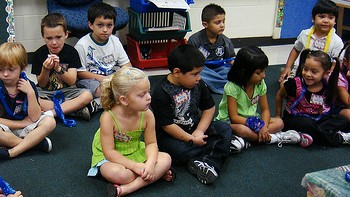
Image by amy.gizienski via Flickr
English learners from ages 0-8, also called dual language learners (DLLs), are a growing population of students who face daunting achievement and graduation gaps. New guidance out recently from the Department of Education highlights some opportunities for pre-k through third grade system improvements for DLLs under the Every Student Succeeds Act (ESSA), specifically around how school districts may spend their funds for Title III. Title III provides approximately $760 million to states to improve instruction for English learners and immigrant students. These funds could be used to create better systems for DLLs if school districts partner with early childhood education (ECE) providers to take up some of the options in the new law and run with them.
- Include pre-k teachers in professional development: First, ESSA specifically encourages states and districts to include preschool teachers in professional development on improving teaching skills for DLLs. This includes school-based ECE teachers, as well as Head Start teachers and community-based providers. Simply getting elementary school teachers and community-based ECE teachers in the same room is unusual, doing so while addressing the diverse needs of DLL students could be could be a big step forward.
- Support effective language instruction across ECE: The guidance encourages school districts to make preschool language instruction part of their overall language instruction strategy, and this doesn’t only apply to on-site classrooms: school districts may sub-grant some of their Title III funds to support DLL instruction in ECE settings. While schools are rarely thrilled to give away funds, early action to support DLLs will yield dividends once those students transition into elementary schools.
- Engage families early: ESSA adds a new Title III spending requirement: parent and family engagement. Families are young children’s most important resource for language learning and healthy development, as was reaffirmed in a joint policy statement on DLL family engagement earlier this year. Under ESSA, Title III family engagement is not limited to K-12 schools; school districts can use Title III funds to support DLL family engagement in ECE settings, and the guidance gives examples of how Title III can be used to support broader family engagement efforts.
- Share data effectively with ECE providers to inform improvement: School districts are required to share data and coordinate activities on DLL instruction with local Head Start agencies and other ECE providers, on topics such as standards, curricula, instruction, and assessments. The requirements on what data to share and what activities to coordinate aren’t very specific, but the aim is to create “a feedback loop that informs the improvement of programs and supports,” for DLLs. If this is done well, ECE providers could see how their DLL students are doing in elementary school, and open lines of communication could help schools and ECE providers both improve.
This is all a lot to accomplish with a limited pool of Title III funds — 71% of Title III school districts found funding for DLLs to be a moderate or major challenge according to a national evaluation published in 2012. But, with smart coordination, combining funding from other grant programs and funding streams, and improved relationships between schools and ECE providers, ESSA Title III requirements could be the nudge some school systems need to take action towards building better pre-k through third grade systems for DLLs and all young students.
